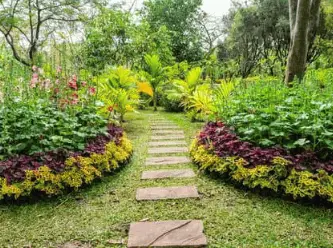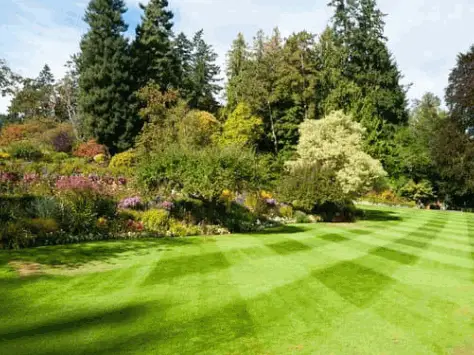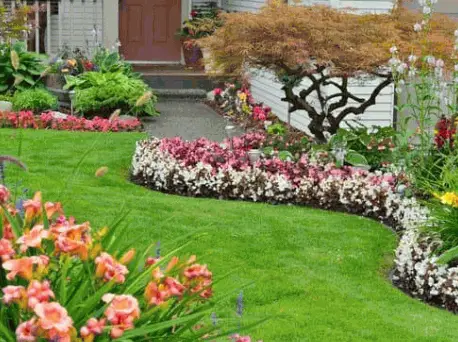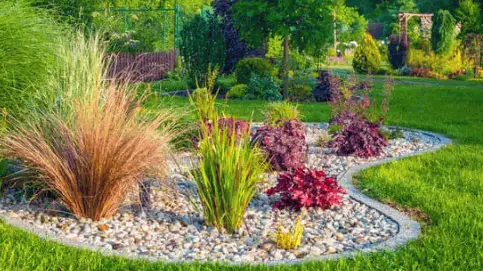Garden aspects refer to the different orientations or directions a garden faces. The aspect of a garden determines how it interacts with sunlight and shade throughout the day. Equipment Girl is here to help you understand the main garden aspects, which are:
North Aspect: A garden facing north receives the most shade and less direct sunlight compared to other orientations. It is generally cooler and tends to have more shade-loving plants.
South Aspect: A south-facing garden receives ample sunlight throughout the day, making it ideal for sun-loving plants. It is generally warmer and creates a favourable environment for many plants.
East Aspect: An east-facing garden receives morning sunlight and enjoys shade in the afternoon. It benefits from gentle morning light, making it suitable for plants that prefer cooler temperatures or partial shade.
West Aspect: A west-facing garden receives afternoon and evening sunlight, often with intense heat. It is ideal for plants that thrive in warm conditions or require direct sunlight during the warmer part of the day.
These different aspects influence factors like the amount and intensity of sunlight, temperature variations, and exposure to wind and shade. Understanding the aspect of your garden can help you choose the right plants, determine where to place structures or seating areas, and create microclimates that suit the needs of your plants and enhance your outdoor experience.
What Does The Southerly Aspect Garden Mean?
South-facing gardens enjoy the maximum exposure to sunlight. This orientation allows the garden to receive ample sunlight throughout the day, making it ideal for sun-loving plants. Southerly garden aspects tend to have warmer microclimates and are well-suited for most heat-loving plants, such as various fruits, vegetables, and flowers that thrive in full sun conditions.

Do North Facing Gardens Receive More Shade?
Gardens with a north aspect generally receive more shade compared to other orientations. This outcome is because they face away from the sun, resulting in less direct sunlight. North garden aspects are often cooler and receive less intense sunlight, making them better suited for shade-loving plants, such as ferns, certain types of moss, and some flowering plants that prefer indirect light.
Are There Any Benefits To West-Facing Gardens?
Yes, there are benefits to having garden aspects that face west. Here are some advantages:
Afternoon Sunlight: These gardens receive the most vital sunlight in the afternoon and evening. This can benefit plants that thrive in warm conditions or require direct sunlight to flower and fruit. It’s ideal for sun-loving plants that help from long daylight hours or must reach their full potential during the warmest part of the day.
Extended Daylight: West gardens often enjoy extended periods of daylight during the summer months. This can be advantageous for plants that require longer photoperiods for flowering that benefit from extended periods of photosynthesis.
The evening sun provides more opportunities for plant growth and productivity. Also, with the evening sun on offer, this is the garden aspect which is ideal for those who like to socialise in the evening.
Sunset Views: A westerly-facing garden offers the opportunity to enjoy beautiful sunset views. It creates a lovely backdrop for outdoor living spaces, providing a tranquil and picturesque setting for relaxation and entertainment.
Shade In The Morning: Gardens facing west tend to receive shade in the morning due to the sun’s positioning. This can benefit plants that prefer cooler temperatures or are sensitive to intense morning sunlight. Morning or midday shade can also help reduce water loss and maintain soil moisture levels.
Protection From Harsh East Winds: In some regions, these gardens can benefit from natural protection against strong east winds. Structures, hills, or vegetation to the east can act as a barrier, reducing the impact of wind on the garden. This can create a more sheltered and favourable growing environment for plants.
While west-facing gardens have their advantages, it’s essential to consider the specific climate, local conditions, and the needs of your plants when planning and designing your garden. Not all plants thrive in the intense afternoon sun or prefer the cooler mornings.

Are There Any Benefits To East-Facing Gardens?
Yes, there are benefits to having an east-facing garden. Here are some advantages:
Morning Sunlight: Easterly-facing gardens receive mostly morning sun, generally cooler and less intense than the heat of the afternoon. This gentle morning sun is beneficial for plants that prefer milder temperatures or are sensitive to intense heat.
Shade In The Afternoon: East-facing gardens tend to receive shade after lunch due to their orientation. This can relieve the hotter part of the day and reduce the risk of sunburn or heat stress in some plants. This shade also stops pale colours from burning, ideal if you have colourful plants.
It can also help conserve soil moisture and prevent excessive evaporation. Early evening shade also offers the chance to relax in comfort after work.
Longer Growing Season: East-facing gardens benefit from sunlight during the cooler part of the day, allowing for an extended growing season. This can be advantageous for early-blooming flowers, cool-season vegetables, and plants that require longer photoperiods for optimal growth and flowering.
Protection From Westerly Winds: In some regions, easterly-facing gardens benefit from natural protection against strong westerly winds. Structures, hills, or vegetation to the west can act as a barrier, reducing the impact of wind on the garden. This can create a more sheltered and favourable growing environment for plants.
Enjoying Morning Outdoor Spaces: An easterly facing garden and property provide the opportunity to enjoy breakfast or morning activities in outdoor spaces, as they receive sunlight early in the day. This can enhance your outdoor experience and allow you to make the most of the pleasant morning hours. There is also evening shade if you prefer a cooler environment at night.

What Is The Best Aspect For A Garden?
The best garden aspects depend on various factors, such as the local climate, the specific plants you intend to grow, and your gardening goals. While a southerly aspect is generally considered desirable due to its abundant sunlight, there may be better choices for some situations.
Certain plants may benefit from partial shade or specific light conditions. It’s essential to consider the particular requirements of your plants and assess the sunlight patterns in your location when determining the best aspect for your garden. Our post “Arthritis Garden Tools” maybe interest you. You can check it out.
Afternoon Shade Protects Plants From The Sun At Its Hottest
Yes, afternoon shade can be beneficial for specific plants. While most heat-loving plants require sunlight for photosynthesis and growth, intense sun and heat can sometimes be detrimental, especially in hot climates or during the summer months. Excessive heat and direct sunlight can cause sunburn, wilting, and plant stress.
Providing shade after lunch helps protect plants from the harsh effects of the sun, reduces water loss through evaporation, and creates a more favourable microclimate. It can help prevent overheating and sunscald, allowing plants to maintain their health and vitality. Garden shade can also reduce the risk of moisture loss from the soil, helping to conserve water and maintain proper hydration for the plants.
Consider Garden Design Benefits If You Enjoy Strong Sunlight
Some plants, particularly those adapted to full sun conditions, may not tolerate excessive shade and require direct sunlight for proper growth and flowering. For more information check out our post “Gardening Tools For Bad Backs“.

Garden Maintenance Tips For Each Garden Aspect
Here are some quick garden maintenance tips for each orientation:
North Facing Garden Maintenance Tips:
- Choose shade-loving plants that can thrive in cooler conditions.
- Keep an eye on soil moisture levels as north-facing gardens tend to retain more moisture.
- Prune or trim trees and nearby structures to maximize the available sunlight.
- Provide wind protection for more delicate plants.
- Regularly monitor for signs of pests and diseases due to potentially higher humidity levels.
Don’t also miss our article on how to prune, cut & trim hedges a beginners guide – it offer valuable insights into this important topic.
South Facing Garden Maintenance Tips:
- Select sun-loving plants that can tolerate and thrive in full sun conditions.
- Water the garden adequately, especially during hot and dry periods.
- Apply mulch to help retain soil moisture and prevent weed growth.
- Monitor for signs of sunburn or heat stress in plants and provide shade if necessary.
- Consider installing shade structures or using shade cloth to provide relief during extreme heat.
East Facing Garden Maintenance Tips:
- Take advantage of the morning sun by planting early-blooming flowers and vegetables.
- Monitor moisture levels as east-facing gardens can dry out faster due to morning sun exposure.
- Provide some shade to protect plants from intense heat.
- Watch for potential issues with morning frost during colder seasons.
- Regularly prune trees and plants to prevent excessive shading.
West Facing Garden Maintenance Tips:
- Ensure adequate watering, especially during hot and dry periods as west-facing gardens can experience more intense afternoon heat.
- Apply mulch to conserve soil moisture and regulate temperature.
- Protect more delicate plants from intense sun and heat by using shade cloth or positioning them strategically.
- Keep an eye on soil moisture levels as a westerly-facing garden might dry out faster.
- Regularly prune trees and shrubs to manage shade and encourage airflow.
Remember, these tips are general guidelines, and it’s important to consider your specific climate, garden shade, soil conditions, and plant selection when maintaining your garden. Regular observation, watering, fertilising, and appropriate pest control practices are essential for a healthy and thriving garden, regardless of its orientation.
What Trees And Plants Flourish In Specific Garden Aspects?
Here’s a list of trees, plants, and flowers that generally grow well in different garden orientations:
South Facing Garden:
- Sunflowers (Helianthus annuus)
- Lavender (Lavandula spp.)
- Roses (Rosa spp.)
- Tomatoes (Solanum lycopersicum)
- Basil (Ocimum basilicum)
- Geraniums (Pelargonium spp.)
- Marigolds (Tagetes spp.)
- Succulents (Various species, such as Sedum and Echeveria)
- Olive trees (Olea europaea)
North Facing Garden:
- Ferns (Various species, such as Asplenium and Polystichum)
- Hostas (Hosta spp.)
- Astilbes (Astilbe spp.)
- Begonias (Begonia spp.)
- Impatiens (Impatiens spp.)
- Japanese Maple (Acer palmatum)
- Hydrangeas (Hydrangea spp.)
- Foxgloves (Digitalis purpurea)
- Rhododendrons (Rhododendron spp.)
East Facing Garden:
- Morning Glory (Ipomoea spp.)
- Daylilies (Hemerocallis spp.)
- Peonies (Paeonia spp.)
- Pansies (Viola spp.)
- Sweet Peas (Lathyrus odoratus)
- Camellias (Camellia spp.)
- Columbines (Aquilegia spp.)
- Ferns (Various species, such as Athyrium and Dryopteris)
West Facing Garden:
- Roses (Rosa spp.)
- Zinnias (Zinnia spp.)
- Sunflowers (Helianthus annuus)
- Evening Primrose (Oenothera spp.)
- Hollyhocks (Alcea rosea)
- Salvia (Salvia spp.)
- Rudbeckias (Rudbeckia spp.)
- Delphiniums (Delphinium spp.)
- Coreopsis (Coreopsis spp.)
- Sun-loving grasses like Feather Reed Grass (Calamagrostis acutiflora)
No matter where your garden faces, certain plants work better than others. Equipment Girl has advised for gardeners to capitalise on the sunshine at their property, buildings, or space.

